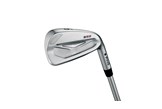PING launch new S55 irons
Published: Last updated:
Ping’s S family of irons (S56, S57, S58, S59) have enjoyed lots of success on Tour in the hands of players like Bubba Watson, Hunter Mahan and Louis Oosthuizen among others. The new S55s are subtly different – and Mahan is said to be hitting them longer and higher than his S56s.
The prototypes were about an eighth of an inch larger than the S56s. That detail would go unnoticed in any other Ping line. But it didn’t cut it for an S-series iron, which has to fit the eye of a very particular group of testers – Tour pros.
“The players noticed immediately,” said Mike Nicolette, senior design engineer for Ping. “They all said ‘I would almost prefer that it would be a little smaller.’”
Unlike most of us, that audience isn’t looking for more forgiveness (though Nicolette said that it wouldn’t hurt them). They place more value on an iron’s looks, feel and workability. That’s why there aren’t any huge changes, but a series of subtle tweaks to improve performance.
So what’s new?
1 The cavity insert
At address, the S55 and S56s look almost identical, but as Hunter Mahan says the S55’s “feel” different. That’s because Ping swapped the thermoplastic urethane (TPU) insert that was used on the S56s for a thermoplastic elastomer (TPE) insert, which Nicolette says is a more flexible material which can absorb more vibration at impact. For most golfers, that translates into a softer feel.
2 Larger Custom Tuning Port
The TPE insert, which Ping calls its Custom Tuning Port (CTP), is also larger in the S55s, meaning it takes up more space in the centre of the head. That frees up more weight for Ping engineers to redistribute to the edges, giving them a 0.5% higher moment of inertia (MOI) than the S56s. That doesn’t sound like much, but according to Nicolette, it can make a difference. A 0.5-inch mishit with a 7-iron will fly two yards further with an S55 than a S56; a big deal for better players aiming at a tight pin.
3 A different centre of gravity
Recent irons from Ping have seen progressive sole widths, so the long irons have wider soles than the short irons to help golfers hit them higher. That’s not the case with the S55s. But they do have an element of a progressive design. Nicolette says that the four grams of discretionary weight the larger CTP frees up lets the long irons have a lower, more rearward CG to help you hit them higher, while the short irons have a CG further forwards in the head to make them fly a little lower.
4 Loft conversion
Maybe the biggest change golfers will notice is in the lofts of the short irons, which are strengthened about one degree. That will make them fly a little farther — about four yards, Nicolette said. Though the lofts of the mid- and long irons are relatively unchanged (the S55 6-iron measures 30 degrees, 0.5 degrees stronger, the 4-iron is 0.25 degrees weaker), their lower CG should help them fly a little further.

